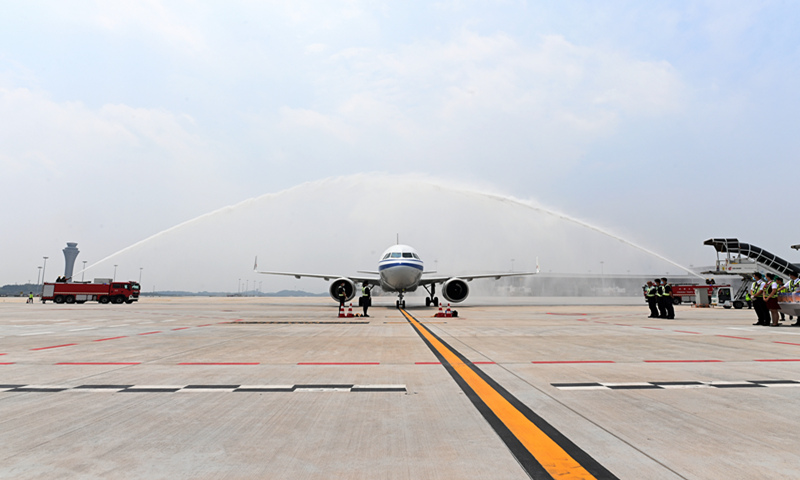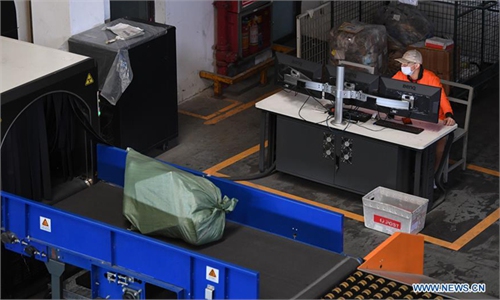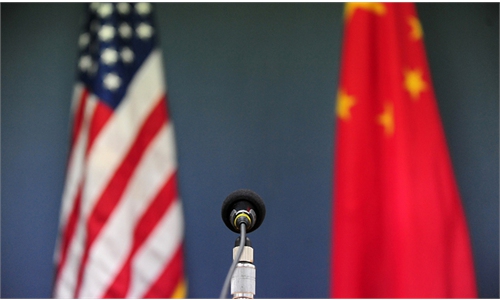
The first plane lands at Chengdu Tianfu International Airport in Southwest China's Sichuan Province, which was officially opened on Sunday. The airport is expected to see 60 million passenger trips and cargo throughput of 1.3 million tons each year. Photo: cnsphoto
China Foreign Ministry said on Thursday that the US has no ground to limit inbound air passenger capacity on Chinese carriers, and China has always adopted equal epidemic prevention and control policies for any plane entering China.
The comment from Hua Chunying, a spokesperson for the ministry, was in response to US regulator's move to limit passenger capacity for Chinese airlines for several weeks.
The US move came after a United Airlines UA857 was found to be carrying five positive COVID-19 cases on July 22, and the flight's passenger capacity was restricted to no more than 40 percent for four weeks starting on August 9.
The US government says China's "circuit breaker" policy violates the nations' air services agreement and "places undue culpability on carriers with respect to travelers that test positive for COVID-19 after their arrival in China," according to Reuters.
In response, Hua said that the "circuit breaker" policy for overseas flights is an important measure to curb imported cases, and the policy is fair and transparent for airlines from home and abroad.
Hua added that on China-US routes, domestic airlines such as Air China and China Eastern Airlines have also been banned for flying for weeks over imported cases, and China has never implemented such measures on for airlines that do not have imported cases.
China will continue to implement epidemic prevention measures, including the "circuit breaker" policy, to prevent the virus from spreading, Hua added.
China Eastern Airlines said on Thursday on its official twitter-like Weibo account that passengers on flight MU587 from Shanghai to New York on August 31 and Sep 5 will be limited to 40 percent capacity, following the US' move.
Four Chinese airlines - Air China, China Eastern, China Southern Airlines and Xiamen Airlines - fly between China and the US.
United Airlines, American Airlines and Delta Airlines are the carriers from the US.
On July 21, five inbound passengers on flight UA857 from San Francisco to Shanghai tested positive when entering China. United had three choices: cancel two San Francisco to Shanghai flights, operate two without passengers, or operate four flights with up to 40 percent passenger capacity. United chose the third option.
The limits come as many Chinese students are headed to the US for the start of fall classes, and such measures are likely to cause booking problems.
Media reports claimed that Chinese students queued up at Shanghai Pudong International Airport to check in for their flights to the US, with lines as long as 1,000 meters.
Several airlines also told the Global Times that flights from Beijing and Shanghai to the US via Hong Kong are in high demand, and airport check-in times and queues are very long.
Market watchers said that as the US is curbing traffic carried by Chinese airlines to the US, more students can only go to the US through connecting flights, which will further increase the ticket prices.
Data from qunar.com sent to the Global Times showed that in August, the average price of a one-way transfer ticket to the US was 22,728 yuan, almost one-third higher than the one-way direct flight ticket.
From August 9 to 15, a total of 42 direct flights flew from the Chinese mainland to the US, and Beijing, Guangzhou and Shanghai were the main departure points, according to data from FlightMaster.


